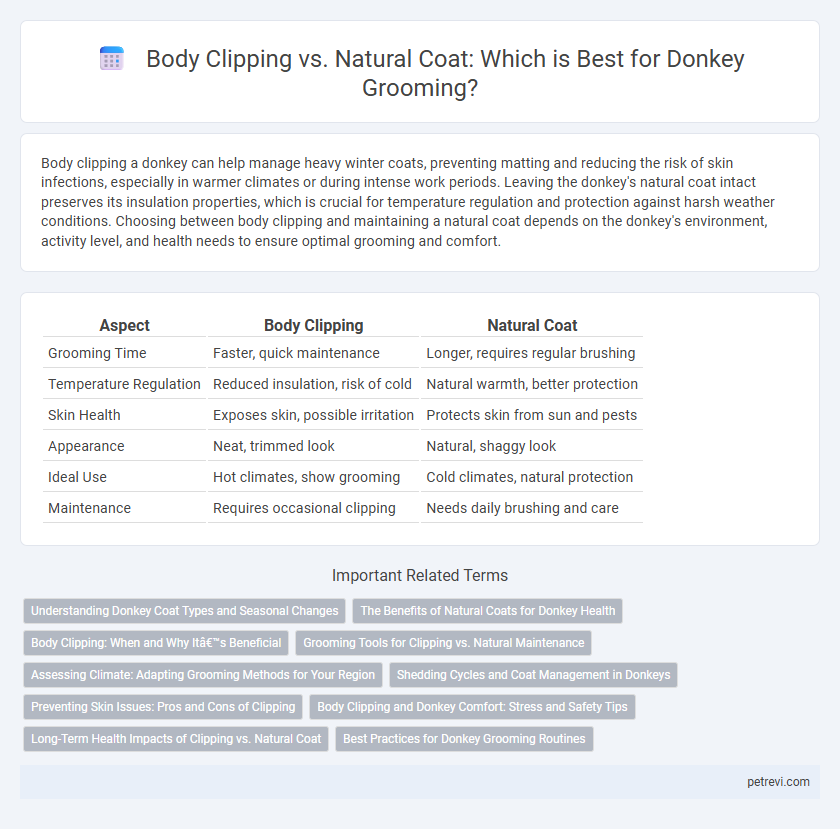Body clipping a donkey can help manage heavy winter coats, preventing matting and reducing the risk of skin infections, especially in warmer climates or during intense work periods. Leaving the donkey's natural coat intact preserves its insulation properties, which is crucial for temperature regulation and protection against harsh weather conditions. Choosing between body clipping and maintaining a natural coat depends on the donkey's environment, activity level, and health needs to ensure optimal grooming and comfort.
Table of Comparison
| Aspect | Body Clipping | Natural Coat |
|---|---|---|
| Grooming Time | Faster, quick maintenance | Longer, requires regular brushing |
| Temperature Regulation | Reduced insulation, risk of cold | Natural warmth, better protection |
| Skin Health | Exposes skin, possible irritation | Protects skin from sun and pests |
| Appearance | Neat, trimmed look | Natural, shaggy look |
| Ideal Use | Hot climates, show grooming | Cold climates, natural protection |
| Maintenance | Requires occasional clipping | Needs daily brushing and care |
Understanding Donkey Coat Types and Seasonal Changes
Donkeys have two primary coat types: a dense winter coat that provides insulation and a shorter, sleeker summer coat that facilitates cooling. Seasonal changes trigger natural shedding cycles, making it essential to understand these variations for proper grooming and body clipping. Body clipping removes excess winter hair to prevent overheating and skin issues, while maintaining a natural coat supports the donkey's ability to regulate temperature effectively throughout the year.
The Benefits of Natural Coats for Donkey Health
Natural coats provide donkeys with essential insulation that regulates body temperature and protects against environmental elements such as sun, wind, and rain. Maintaining a natural coat supports the donkey's skin health by preventing irritation and preserving natural oils that promote a healthy barrier against parasites and infections. This grooming approach reduces stress on the animal and enhances overall well-being by allowing the donkey's coat to function as a natural defense system.
Body Clipping: When and Why It’s Beneficial
Body clipping donkeys is beneficial during warmer months or in climates where heavy fur causes overheating, reducing the risk of heat stress and improving comfort. It also helps prevent skin issues like fungal infections and makes grooming easier by removing dirt and debris trapped in thick coats. Regular body clipping supports better hygiene and health, especially for working donkeys or those with limited natural shedding.
Grooming Tools for Clipping vs. Natural Maintenance
For donkey grooming, body clipping requires specialized electric clippers with adjustable blades and fine-tooth combs to safely trim the thick coat without causing skin irritation. Natural coat maintenance relies on stiff-bristled brushes, rubber curry combs, and shedding tools to remove dirt, loose hair, and debris while promoting healthy skin. Selecting the right grooming tools improves coat condition and comfort, tailored to whether the donkey is clipped or maintained naturally.
Assessing Climate: Adapting Grooming Methods for Your Region
Assessing climate is crucial for determining whether body clipping or maintaining a natural coat is best for donkey grooming. In colder regions, preserving the natural coat helps retain insulation and protects donkeys from harsh weather. Conversely, in warmer climates, body clipping can prevent overheating and reduce the risk of skin infections caused by sweat accumulation.
Shedding Cycles and Coat Management in Donkeys
Donkeys experience seasonal shedding cycles that significantly impact their coat management, with natural coats providing insulation and protection suited to their environment. Body clipping can disrupt these cycles by removing essential hair layers, potentially leading to increased sensitivity to weather and skin injuries. Effective grooming balances maintaining the natural coat's protective qualities while managing shedding to prevent matting and skin issues.
Preventing Skin Issues: Pros and Cons of Clipping
Body clipping a donkey removes excess hair, improving ventilation and reducing the risk of skin infections such as rain rot and fungal growth. However, clipping can expose the skin to sunburn and cold, potentially causing irritation and necessitating additional protections like sunscreen or blankets. Leaving the natural coat intact preserves the donkey's natural barrier against weather elements but requires regular grooming to prevent matting and parasitic infestations.
Body Clipping and Donkey Comfort: Stress and Safety Tips
Body clipping donkeys significantly reduces shedding and helps maintain hygiene, but improper clipping can cause stress and skin irritation. To ensure donkey comfort during body clipping, use sharp, clean clippers and clip in the direction of hair growth, taking frequent breaks to avoid overheating. Providing a calm environment, gentle handling, and gradual acclimatization to the clipping process enhances safety and minimizes anxiety for the donkey.
Long-Term Health Impacts of Clipping vs. Natural Coat
Clipping a donkey's coat can reduce the risk of overheating and make dirt removal easier, but it may expose the animal to cold stress and skin irritations if not managed properly. A natural coat provides essential insulation against temperature fluctuations and protects against sunburn and insect bites, promoting overall skin health. Long-term reliance on clipping without adequate care can lead to weakened fur regrowth and compromised immune resilience, whereas maintaining a natural coat supports the donkey's natural thermoregulation and skin barrier functions.
Best Practices for Donkey Grooming Routines
Body clipping donkeys can help maintain hygiene and reduce parasite load, especially in warmer climates or for donkeys with thick, dense coats prone to matting. However, preserving the natural coat allows for better temperature regulation and protection against sun and insect bites, making careful grooming and regular brushing essential. Best practices include assessing the donkey's environment and health needs to determine if partial clipping is appropriate, paired with routine grooming to remove dirt and debris while supporting skin health.
Body Clipping vs Natural Coat for Donkey Grooming Infographic

 petrevi.com
petrevi.com